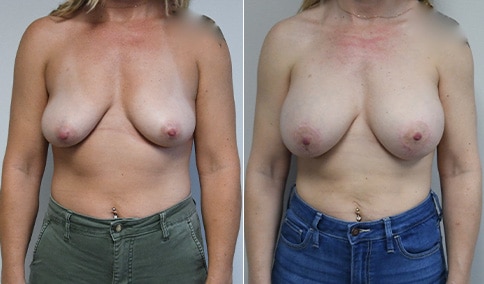
Breast Augmentation with a Mastopexy – Patient 333
Learn about patientBreast Augmentation with a Mastopexy – Patient 333
A mother of 1 in her late 30’s who is bothered by a deflated and drooping appearance of her breasts after weight loss and pregnancy. She wanted to be fuller and less droopy in appearance. She is shown before and again, 7 months after augmentation mastopexy ( a breast at the time of breast implant placement.)
Discussion: She is 5 1 ½ and 120 lbs. She had Sientra High strength round smooth cohesive gel 350 cc high profile implants placed in a partial subpectoral position at the time of an inverted T mastopexy. She did not want a larger implant that might draw to much attention in her workplace and likes the natural but fuller look.
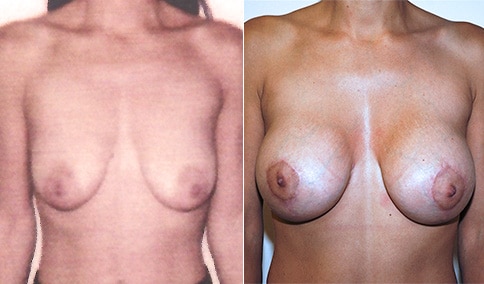
Breast Augmentation & Mastopexy – Patient 315
Learn about patientBreast Augmentation & Mastopexy – Patient 315
A long term followup on a mother of 2 in her early 50’s who presented in her mid 30’s with deflated breasts after pregnancy. She is 5’ 4” and 116 lbs.
She elected for a smooth round saline implant placed through a vertical mastopexy position in a subglandular space. When the breasts are a little droopy the subglandular placement allows the implants to settle with the breasts and avoid a “waterfall “ effect of the implants falling off of a mound which can happen with a subpectoral placement. We were conservative with the size of the implants which have prevented excessive stretching and still fit her frame. Her breasts have changed remarkably little in the 15 years since her surgery.
She asked about whether she should change her implants now that they are 15 years old- the answer is no- she is doing great, and it will be easy to tell if and when her implants eventually leak because the saline implants will visibly deflate. But even though 8% of saline implants may have leaked by 10 years, the rest have not and she will hopefully get many more years out of her implants.
followup on a mother of 2 in her early 50’s who presented in her mid 30’s with deflated breasts after pregnancy. She is 5’ 4” and 116 lbs.
She elected for a smooth round saline implant placed through a vertical mastopexy position in a subglandular space. When the breasts are a little droopy the subglandular placement allows the implants to settle with the breasts and avoid a “waterfall “ effect of the implants falling off of a mound which can happen with a subpectoral placement. We were conservative with the size of the implants which have prevented excessive stretching and still fit her frame. Her breasts have changed remarkably little in the 15 years since her surgery.
She asked about whether she should change her implants now that they are 15 years old- the answer is no- she is doing great, and it will be easy to tell if and when her implants eventually leak because the saline implants will visibly deflate. But even though 8% of saline implants may have leaked by 10 years, the rest have not and she will hopefully get many more years out of her implants.
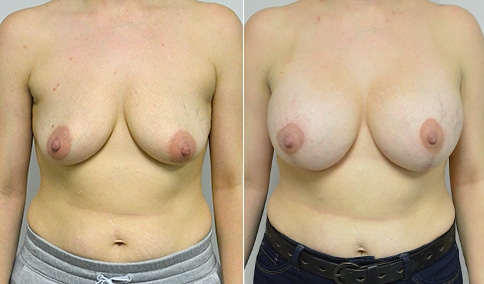
Breast Lift with Implants – Patient 104
Learn about patientBreast Lift with Implants – Patient 104
A mother of 4 who is bothered by a deflated appearance of her breasts after pregnancy and wants a full but still natural look. She describes herself as a 36B and would like to be a full C cup. Her right nipple is 0.5 cm below her breast fold and her left nipple is 1.5 cm below her breast fold. “second degree ptosis” or drooping. She would not be able to be treated well with breast implants alone, and chose a breast lift with implants. She wished to try and maintain some fullness of her upper breasts. After reviewing the options and careful sizing in the office based on her measurements, she elected for a 450 cc high profile round textured surface implant, placed in a dual plane position. The high profile implant helps to fill her upper breast- it may not be an appropriate choice for a woman who has never had children because it might stretch a tight breast too much- in her case her breast is “loose” after children. We would like to fill but not overly stretch the breast. The high profile is a good fit here.
The use of texture is a more complicated decision. Smooth implants tend to shift to the sides and bottom out more with time. This is especially a problem when we are performing a breast lift with implants, because the breasts have already shown us that they are not as elastic. I tell my patients that its not just the tailor, but the fabric that impacts the result. Texture may help to decrease this tendency to shift. Texture has been associated with the rare condition of BIA-ALCL, at type of lymphoma that is found only around textured implants and is associated with biofilm, a kind of bacterial contamination. BIA-ALCL is possible but extremely rare, and very treatable when properly diagnosed. It may be more of a risk with the more aggressively textured implants, so when we choose texture I prefer the less aggressively textured surface. In her case balancing the tradeoffs she has chosen to use texture. She is now shown nearly 1 ½ years after her surgery. The mastopexy scars continue to fade for up to two years. Her implants have been stable. A ”dual plane” position allows the edge of the pectoralis muscle to rise up to the lower edge of the areola after it is released, so that the implant is below the muscle in the upper breast , and below the breast in the lower breast. IF an implant is entirely below the muscle the implant stays in position and the breast can drop off- a “waterfall” effect. When the implant is above the muscle it will drop with the breast, but there is a higher risk of a capsular contracture, it is a little more difficult to perform a mammogram, and the breasts may stretch more and not age as well. So the dual plane is a blend of the two. She is thrilled with her fuller but still natural appearance. And we have been fortunate that despite decreased elasticity her breast surgery result has stayed fairly stable with time.
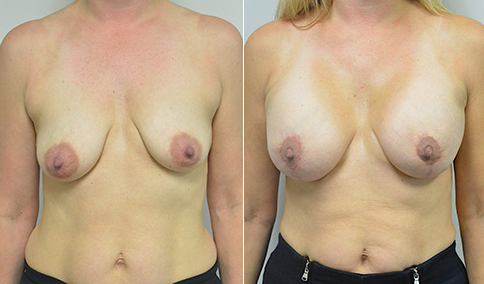
Breast Lift with Implants – Patient 103
Learn about patientBreast Lift with Implants – Patient 103
A woman in her late 30’s with volume loss and drooping of her breasts after 2 pregnancies. She is also bothered by an area of fat accumulation along her anterior axilla.
She is 5’ 5-1/2” and 130 lbs and is shown before and again, 3 ½ months after bilateral augmentation mastopexy combined with power assisted liposuction of the axilla using the S.A.F.E. technique. Textured, round, high profile 350 cc silicone gel implants were placed in a dual plane position. Her scars will typically continue to fade for the next 2 years. She already is thrilled with her improvement. High profile was used to try and restore some upper pole fullness-in a “tight” breast from someone who has never lost weight or been pregnant a high profile can cause too much stretching and atrophy of the breast tissue, but in a woman who has lost upper breast volume it can work well. The idea is to fill the breast but not overly stretch the breast. Texture was chosen to decrease the tendency of the implants to fall to the side or drop with time, which is more likely with a “’stretchy” breast after pregnancy. “Dual plane” position has the implant below the muscle in the upper breast and above the muscle in the lower breast- this allows the implant to settle with the breast but still have the benefits of being covered with the muscle in the upper breast- (less capsular contracture, easier to do a mammogram, and the breast ‘ages’ better) A vertical mastopexy was used (“lollipop incision”)
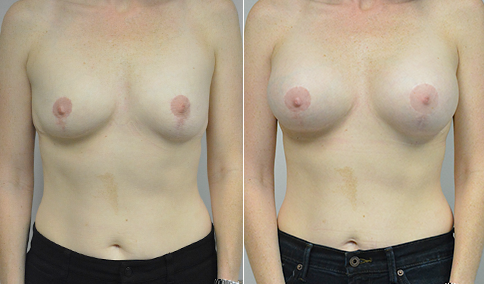
Breast Lift with Implants – Patient 102
Learn about patientBreast Lift with Implants – Patient 102
A mother of 2 in her late 30’s who had a breast reduction/lift in her early 20’s, reducing her to a C cup. She subsequently got married, had 2 children, and her breasts have “deflated”. Her breasts decreased to a 34 A cup, and she was bothered by looseness of the skins on the side of the breast as well. She is shown before and again 1 year after bilateral breast augmentation.. She is 5’6” and 129 lbs and had 350 cc high profile round silicone gel (mentor) textured implant placed in a dual plane position, utilizing a portion of her original breast reduction scar for access. Texture was chosen to decrease risk of lateral shift and dropping of the implants which would be more common given her decreased skin elasticity.
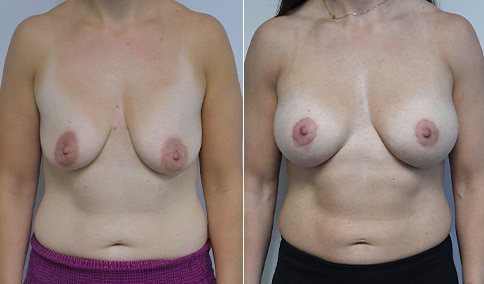
Breast Lift with Implant – Patient 101
Learn about patientBreast Lift with Implant – Patient 101
A mother of 3 in her mid 30’s who is bothered by a deflated appearance of her breasts. Her nipples are each located 1 cm below her breast fold, which is the definition of ptosis or drooping of the breasts. When the nipple is below the breast fold it is generally best to add a mastopexy (breast lift). She is shown before and again, 11 months after augmentatioin mastopexy. 350 cc High profile round textured implants were placed in a “dual plane” location. An inverted T mastopexy was performed.
Explanation of choices made: I prefer round implants for breast augmentation-a recent study showed that trained plastic surgeons cannot tell the difference in photographs between properly sized round and shaped implants. And shaped implants can flip or turn. So round is our choice. When breasts are “loose” there is a tendency for the implants to drop more or slide to the side (lateral shift) with time. Texture may help to stabilize the result. So Texture was chosen. There can be problems with late seroma formation and pseudocapsule formation with more aggressive textures, so I prefer the less aggressive textures for my breast augmentation patients. It is important to “fill “ the breast but not overly stretch the breast. In a tight breast I prefer a moderate profile implant, but breasts that are looser after children (or weight loss) may need more volume to fill the upper breast. So a high profile implant was chosen here.
Implants can go above or below the muscle- below the muscle has the benefits of less capsular contracture, easier to do a mammogram, the breasts “age” better. But in a loose breast the breast can drop off the mound (“waterfall effect” and look unnatural. Implants can go above the muscle, so that they will drop with the breast. But they tend to stretch the breast more, make it more difficult to do a mammogram, have a higher risk of capsular contracture and less “padding” over the cleavage portion of the implant. A dual plane allows the edge of the pectoralis muscle to come up, so that the implant sits below the muscle in the upper breast , and sits below the breast in the lower breast- so that was chosen here.
Mastopexy skin patterns achieve different results. Because the nipple to breast fold distance on stretch was 10 cm in her case, a vertical mastopexy would not work as well and a horizontal component of skin is excised at the breast fold to shorten the distance- this gives an inverted T scar, sometimes called a “WISE” pattern after a physician who described it. Scars will typically continue to fade for another year, but she is already thrilled with her result.
Update: Our patient is now seen 4 ½ years after her surgery. Her scars have faded nicely. Her implants are still soft and have not shifted down or to the sides as we may have expected to see with smooth implants. A good demonstration of how the thoughtful use of a micro-textured breast implant still makes sense in patients who are more at risk of implant shifting in patients who understand the pros and cons of micro-texture.
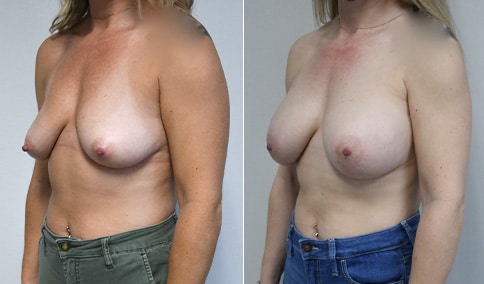
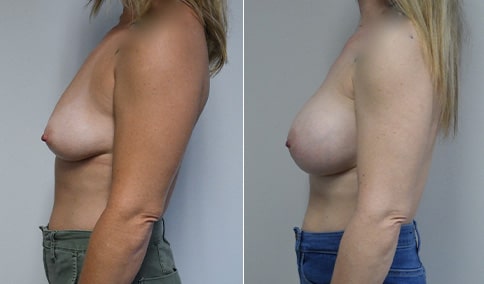
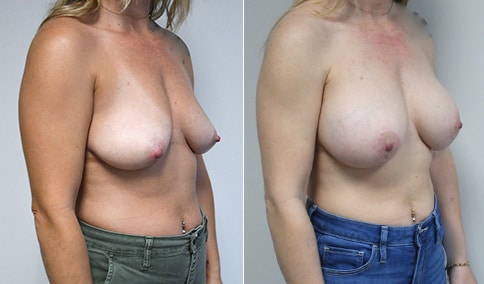
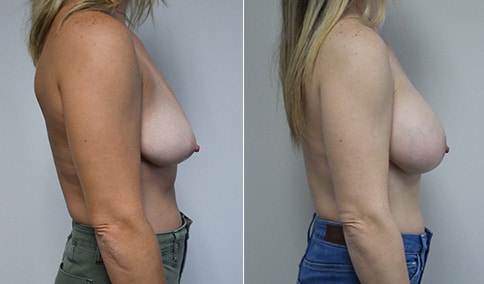
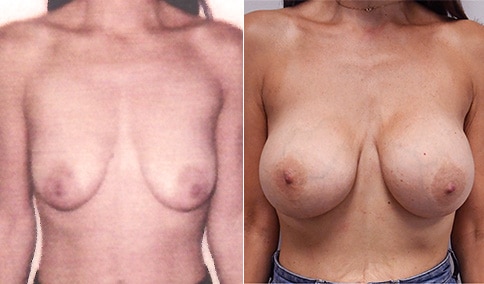
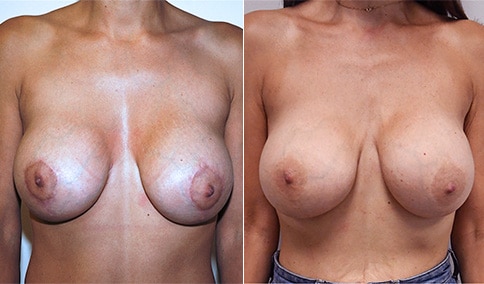
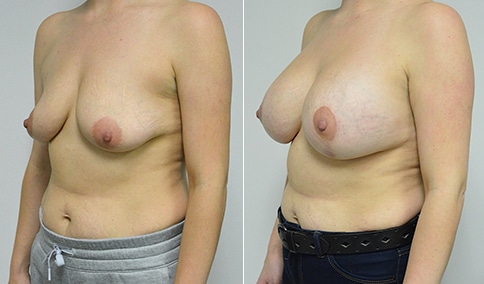
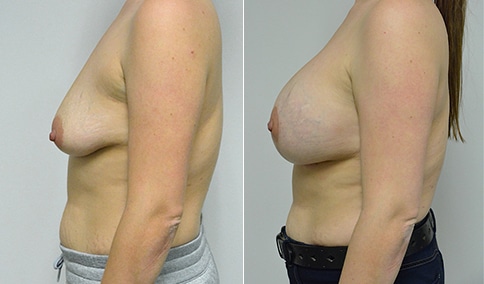
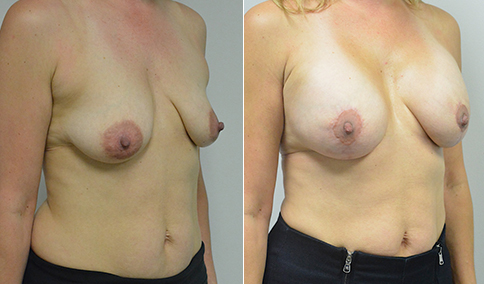
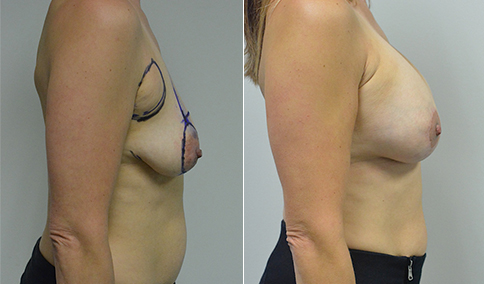
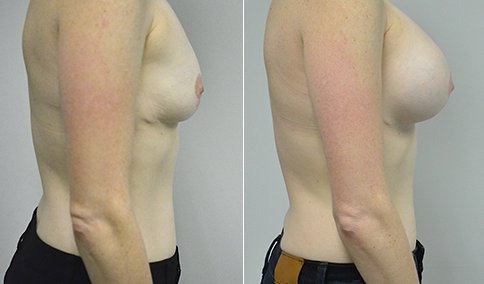
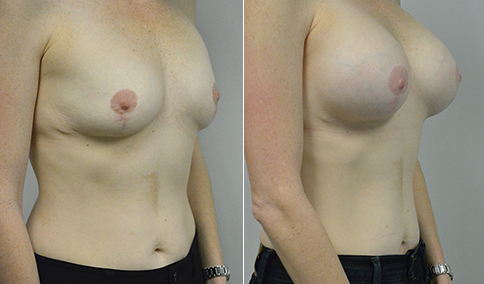
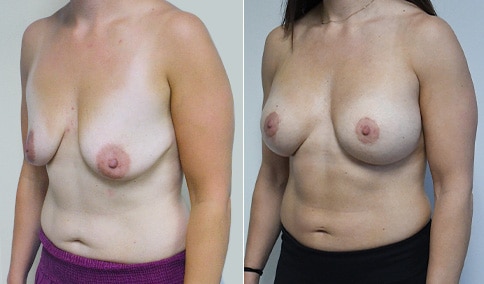
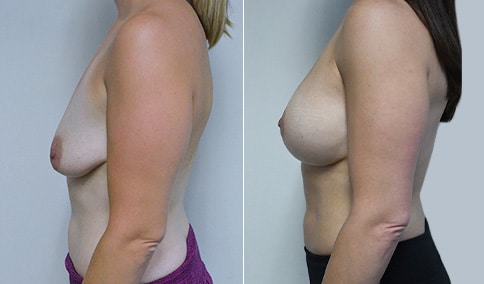
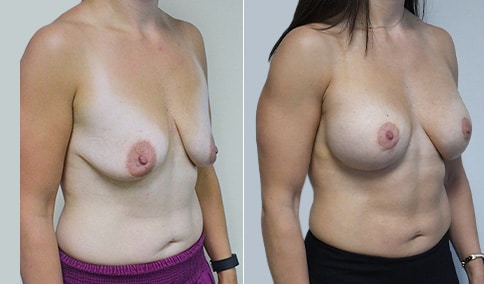
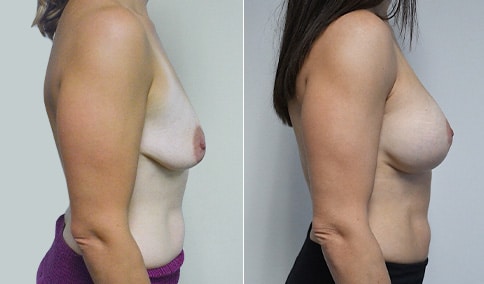





Cosmetic & Plastic Surgery Specialist
"I treat my patients like I would treat
- Jonathan D. Hall, MD, FACSmembers of my own family."
Schedule Consultation